Content
- Normal
- How are inherited
- What do they contain
- Autosomes
- XX
- XY
- Pathology
- Patau syndrome
- Deletion of 3 chromosomes
- Edwards syndrome
- Deletion of chromosome 21
- Cat Scream Syndrome
- Trisomy
- Down Syndrome
- Pentosomy
- Turner syndrome
- Klinefelter's syndrome
- Video about chromosomes
A healthy person has 23 pairs of chromosomesthat serve as a biological sarcophagus for the preservation of tens of thousands of genes. This number of chromosomes can change under the influence of unfavorable factors, which leads to genome mutations. An increase or decrease in the numerical indicator of chromosomes causes anomalies in the physical and mental development of a person, and becomes the cause of genetic pathologies.
Normal
Chromosomes are an integral part of the human genome, which includes a collection of genetic information inherited from the mother and father. An indicator of the norm of the physiological development of the body is the presence of 23 pairs of chromosomes (46 in total) in men and women, located in a single nucleus.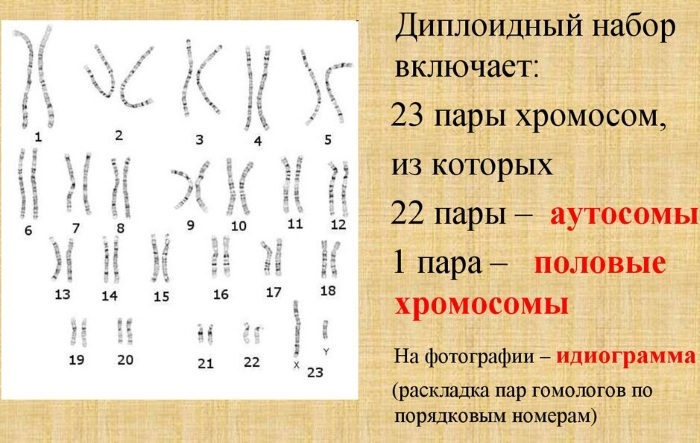
This number of chromosomes, as well as the mitochondrial part of DNA, combine about 3.1 billion. paired bases. An increase or decrease in the numerical indicator of chromosomes indicates the presence of genetic pathologies, which can have a variety of forms and manifestations.
How are inherited
The number of chromosomes in a person is unchanged if the transfer of the genome from parent to child occurred without pathological disorders. The inheritance of this amount of genetic information occurs in such a way that the newborn baby gets 23 pairs of chromosomes from the mother and father.
By maintaining this balance, the child receives an equal number of genes from both parents. This minimizes the risk of genetic diseases, ensures the rational distribution of hereditary information.
What do they contain
Each human chromosome is filled with hundreds of genes, which are separated by an intergenic space. In the intergenic regions, there are separate segments that perform the function of a regulator.
Inside the chromosomes, there is also a part of DNA that is not involved in the coding of proteins, but is important in the preservation of the hereditary information of genes. Recent scientific studies have shown that there are about 28 thousand chromosomes in the structure of human chromosomes. genes that have multiple exons and introns of different sizes.
All chromosomes of the human body are characterized by an uneven distribution of genes. Each chromosome includes separate sections that are very rich in hereditary information, or contain a minimum amount of it.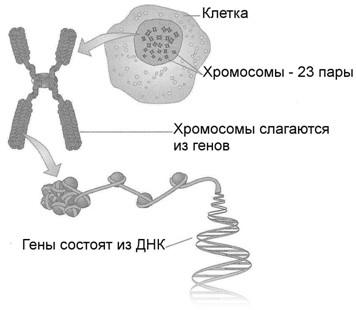
These segments are correlated using chromosomal bands (they are distinguished by the presence of transverse stripes that can be seen through a microscope lens). Until now, genetic scientists cannot decipher the purpose of such an uneven distribution of genes.
The internal structure of chromosomes includes not only genes that encode a protein substance, but also several thousand RNA genes.
This element of the human genome is designed to implement the following functions:
- encodes transport type RNA;
- regulates ribosomal RNA;
- coordinates the activity of microRNA and other forms of RNA.

The chromosomes contain about 98.5% of the DNA that does not take part in protein coding. Most scientists consider this part of the genome to be junk, since it does not affect the transmission of hereditary information. At the same time, there are alternative opinions. Some geneticists believe that 98.5% of "junk" DNA is responsible for the safety and stability of genes inside chromosomes.
Autosomes
In total, there are 22 pairs of autosomal chromosomes in the human body. This is the part of the genome that contains hereditary information from the mother and father. An additional pair of chromosomes (23rd) determines gender.
The pair of autosomes determines what mental and physical abilities a person will inherit. Violation of the paired number of chromosomes of this type leads to the emergence of genetic pathologies. The type and severity of the disease depends on the type of chromosomal mutation.
XX
The number of chromosomes in a person responsible for sexual characteristics should remain unchanged. This is 1 pair XX or XY. Chromosomes XX have the same structure, and their presence determines the female sex. During the conception of a child, along with the total amount of genetic information, a woman transmits only 1 chromosome to the offspring. Given any combination of genes, the sex chromosome from the mother will always be X.
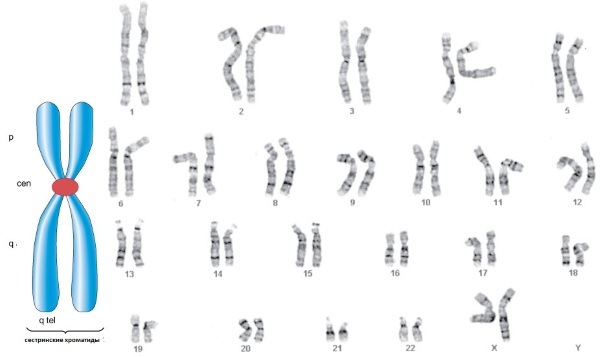
If a similar chromosome was passed on from the father, then the result of fertilization of the egg will be the conception of a girl.
XY
The presence of a pair of XY sex chromosomes is possible only in males. At the moment of conceiving a child, a man can transmit the X or Y chromosome. The further sex of the baby depends on which of the chromosomes had a dominant character.
For example, if a future genome with a male sex chromosome X is formed on the basis of genetic information, a girl will be born. If the Y chromosome is passed on, a boy will be conceived. The complete set of the numerical number of chromosomes is called a karyotype.
Pathology
The number of chromosomes in a person is an indicator of the general state of his genome. Information about the quality of hereditary information is embedded within DNA, and its decoding requires genetic diagnosis. Recent scientific research shows that chromosomal diseases are increasingly common in medical practice. On average, 0.6 to 1% of children are born annually who have chromosome pathologies.
The largest number of genetic disorders of this type is found in embryos rejected by a woman's body as a result of spontaneous abortion. Chromosomal mutations were observed in 70% of the examined material.
The table below shows the abnormal states of the structure of chromosomes, the presence of which leads to the development of genetic pathologies.
| Types of chromosomal abnormalities | Characterization of the mutation |
| Insertion | There is a transfer and insertion of genetic material from one chromosome to another. Hereditary information is not located where it should be according to the laws of genetics. |
| Deletion | Under the influence of various factors, the terminal or interstitial part of the homologue is lost. |
| Translocation | It occurs after the rupture of several chromosomes with an uncontrolled process of exchange of genetic information. |
| Ring chromosome | Pathology is formed as a result of rupture of the short or long arm of the chromosome with further fusion of its centromeric segments. |
| Duplication | An anomaly in the structure of the genetic material, which occurs due to the duplication of chromosomes. |
| Inversion | Pathological change in the sequence of the location of genes within the structure of the chromosome. |
The above types of chromosomal abnormalities cause genetic pathologies with various clinical symptoms, the nature of origin and the severity of the course.
Patau syndrome
Patau syndrome was first investigated in 1960. The incidence of this genetic pathology is 1 in 7800 newborns. This disease develops under the influence of chromosome 13 trisomy. In 80% of cases, the nature of the origin of this pathology is associated with the fact that there is no divergence of chromosomal pairs in meiosis in the mother's body. The child gets congenital abnormalities on chromosome 13.
The presence of Patau syndrome is manifested by the following symptoms:
- cleft palate and tissues of the upper lip (in everyday life, this disease is found under the names "cleft palate" or "cleft lip");
- microcephaly of the brain with the presence of an abnormally small cranium;
- deformational changes in the auricles (this part of the hearing aid may be located below the normal level);
- flexor arrangement of the fingers of the upper extremities;
- too convex nail plates;
- thin and elongated foot;
- polydactyly;
- congenital malformations of the cardiovascular system;
- doubling of the walls of the ureter;
- polycystic neoplasms in the kidneys;
- mutations in the intestinal structure (in most cases, this organ of the digestive system loses the ability to fully work);
- doubling of the reproductive organs in girls (defects affect the uterus and vagina);
- cryptorchidism.
Children born with Patau Syndrome suffer from severe idiocy. Most newborns die between 2 and 3 months of age. The maximum life expectancy with Patau syndrome is 1 year.
Deletion of 3 chromosomes
Deletion of chromosome 3 is a severe genetic pathology, the presence of which causes early death in newborns. In most cases, this genome mutation leads to miscarriage. The mother's body rejects the embryo, which initially has structural damage to chromosome 3.
Children born with this genetic pathology have functional disorders in the central nervous system. A child with a chromosome 3 deletion is unable to eat solid and rough foods. Cerebral disorders lead to the fact that such children cannot sit, constantly fall forward or to the sides.
Edwards syndrome
Edwards syndrome is another severe chromosomal pathology that occurs due to trisomy 18 of chromosome. This disease of the genome occurs in 1 child in 6500 newborns. A cytogenetic mutation of chromosome 18 occurs in the body of one of the parents, and then the child receives a volume of genetic information, which initially contains defective autosomes. In 85% of cases, Edwards syndrome is transmitted through the maternal line.
An important part of the genome, located in the 18g11 segment, is responsible for the appearance of signs of this disease. Babies born with Edwards syndrome are abnormally low in body weight.
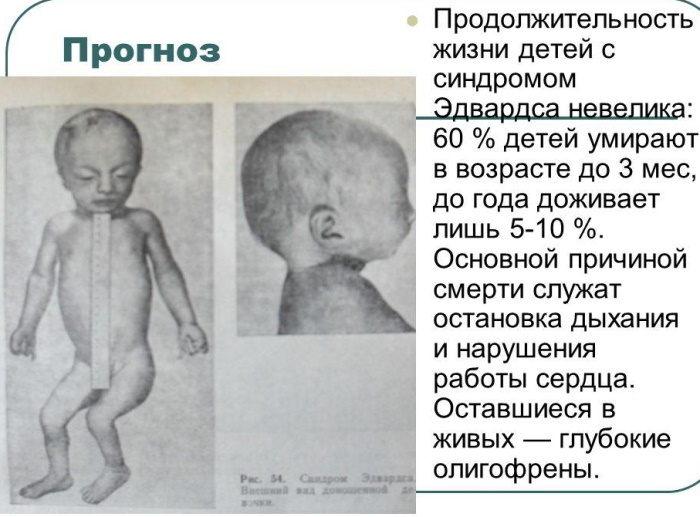
This pathology has the following additional symptoms:
- chin sloping to one side and deformations of the facial bones;
- dolichocephaly;
- too low location of the auricles;
- microstomy;
- deformations of the bones of the fingers, which disrupt the process of their bending;
- hypoplasia of the nail plates;
- the shape of the foot, which visually resembles a rocking chair;
- underdevelopment of the fingers of the lower extremities;
- mutational changes in the structure of the intestine;
- underdeveloped kidneys, which outwardly resemble the shape of a horseshoe (the organ is not able to perform the function of purifying blood and excreting urine).
Children with Edwards syndrome have severe psychomotor retardation, imbecility and complete idiocy. Newborns with this chromosomal abnormality die within the first 12 months. The main cause of death is multiple complications associated with dysfunction of the kidneys, intestines, and brain centers.
Deletion of chromosome 21
This genome pathology affects the development and functioning of the hematopoietic system. Babies born with a chromosome 21 deletion suffer from critically low red blood cell counts. A clinical blood test shows that the child has chronic leukemia.
The danger of this chromosomal pathology lies in the high risk of severe forms of anemia. The prognosis for preserving life depends on the form in which the disease proceeds, the number of healthy red blood cells and the functional activity of the hematopoietic organs.
Cat Scream Syndrome
Cat Scream Syndrome was first described by a group of doctors in 1963. This pathology is caused by monosomy of chromosome 5. The incidence of this genetic disease is in the range of 1 in 5000 newborns.
Cat Scream Syndrome occurs due to partial or complete deletion of the chromosome 5 arm. As a result of a violation of the structure of this chromosome, genetic information located in the 5p15 DNA segment is damaged. A simple deletion can be aggravated by a mosaic form of pathology, the formation of a ring chromosome No. 5.
In clinical practice, there have been cases of complete loss of the arm of chromosome 5 and simultaneous fusion with another autosome. The result of this pathological process is a violation of the order of the genes and the incorrect transmission of hereditary information.
You can recognize the Cat Scream Syndrome by the following:
- the child has an abnormally small skull;
- strabismus;
- too wide bone of the bridge of the nose;
- deformational changes in the auricles, as well as their low location;
- antimongoloid type eye incision;
- unusual sound of crying, which resembles the annoying meow of a cat (this symptom is especially pronounced in the first 2 weeks from the moment the baby is born);
- roundness of the facial disc;
- mental retardation, which is at the level of imbecility;
- kidney defects (in medical practice, there are cases when the functions of this organ are not impaired).
The presence of congenital microcephaly excludes the possibility of full development of the centers of the brain. The life expectancy of newborns with Cat Scream Syndrome depends on the condition of the internal organs. Most babies die in the first years after birth.
Trisomy
Trisomy (Triplo-X syndrome) is a disease that is diagnosed in women. A distinctive feature of this genetic pathology is that, together with hereditary information, a person acquires not 2, but 3 sex chromosomes XXX.
The frequency of diagnosis of this disease is 1 in 700 newborn girls. Women with trisomy can live their entire lives without realizing that they have this chromosomal abnormality. Trisomy is determined only by genetic blood tests.
Triplo-X syndrome is characterized by the presence of the following symptoms:
- functional disorders in the work of the ovaries;
- premature onset of menopause;
- various pathologies on the part of the organs of the reproductive system;
- minor deviations in physical development, which may be completely absent.
Trisomy XXX does not affect life expectancy, but significantly reduces its quality. Women with this mutation experience an imbalance in sex hormones, and quite often suffer from primary infertility.
Down Syndrome
Down syndrome develops in children with trisomy 21 of chromosomes. This is one of the most common genetic abnormalities affecting boys and girls alike. In the karyotype of newborn babies with Down syndrome, there are not 2, but 3 X chromosomes of 21 pairs.

The incidence of this genetic disorder is in the range of 1 in 500 newborn babies.. The likelihood of developing this mutation depends on the biological age of the child's mother. The older the woman, the more likely it is that a baby with an extra chromosome 21 will be born.
Down syndrome is manifested by the following symptoms:
- abnormally wide forehead and bridge of the nose;
- mental retardation;
- Mongoloid form of the facial disc;
- disproportionately short upper and lower limbs;
- flat nape;
- deformation of the tissues of the auricles;
- the eyes are located at a great distance;
- short and wide neck;
- small nose;
- the presence of a constantly open mouth and an abnormally large tongue;
- strabismus;
- violation of the bite (the lower jaw is slightly pushed forward).
Down syndrome may be accompanied by additional mutations in the form of malformations of internal organs, a too weak immune system. Children with this genetic abnormality are more likely to suffer from infectious diseases than their peers.
Violations of the central nervous system lead to the fact that the child begins to walk late, he has problems with coordination of movements, diction. Heart, kidney, gastrointestinal tract defects, as well as an overly vulnerable immune system are the main causes of death in children with Down syndrome. In most cases, death occurs in the first 5 years of life.
Pentosomy
The number of chromosomes in a person should not exceed 23 pairs. Otherwise, congenital genetic abnormalities develop, which lead to the death of the child or severe disability. Pentosomy is a pathology that occurs due to an increase in the number of sex chromosomes.
This disease is diagnosed only in women. A distinctive feature of pentosomy is that in the genome of newborn girls there are not 2 sex chromosomes, but as many as 5 (XXXXX). Children born with this anomaly have multiple defects of internal organs and dysfunctions of the brain. Death occurs in the first 1-2 months. life.
Turner syndrome
Turner syndrome is a genetic disorder also known as X0 monosomy. This pathology can only be diagnosed in women. A distinctive feature of this disease is that the child receives only 1 sex chromosome X. The result of the mutation is mental and physical retardation.
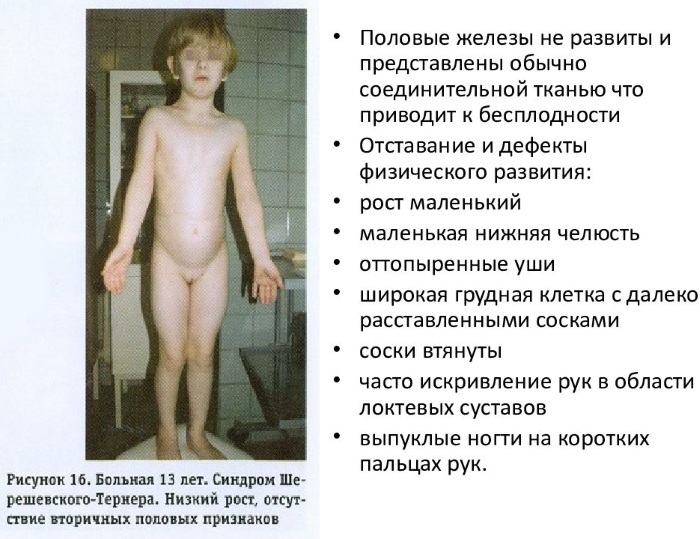
Girls born with Turner syndrome have an underdeveloped uterus as well as ovaries. Monosomy X0 occurs in 1 child in 4000 newborns. Turner's cider is considered a chromosomal abnormality that is fully compatible with life.
Klinefelter's syndrome
Klinefelter syndrome is a complex chromosomal disorder that occurs in 2 forms. This pathology affects only males. In the first case, polysomy along the line of the X chromosome is possible.
Men born with the XXY genome have the following effeminate traits:
- well-developed mammary glands;
- long legs and a female figure;
- testes are present, but they are not functional due to underdevelopment;
- female timbre of voice.
Men with sex chromosomes XXY have a normal level of mental and intellectual development. Internal organ defects are completely absent. The upper and lower limbs are proportional. Men with X-line chromosomal abnormalities are infertile.
The second form of manifestation of Klinefelter syndrome is Y-chromosome polysomy. In this case, a child is born whose genome contains 3 sex chromosomes - XYY. This mutation can only be diagnosed in males. Patients with this form of Klinefelter's syndrome do not have physical and mental defects.
Men with an abnormal set of XYY chromosomes are tall, full of intelligence and a normal physique. The presence of an extra sex chromosome Y only leads to the fact that these men are distinguished by pronounced aggressiveness, irascibility and irritability. Most of the owners of this chromosomal pathology lead an asocial lifestyle.
A person who does not have genetic pathologies has 23 pairs of chromosomes without signs of damage. All of them are part of a single genome structure. Each chromosome contains hundreds of genes containing important hereditary information that is necessary for the full development of the body. 22 pairs of autosomal chromosomes are responsible for the transfer of genetic data. Determining the sex of a child is performed by fusing 23 pairs of chromosomes.
The karyotype of the female body contains a set of chromosomes XX, and the male genome contains a combination of XY. During the conception of a child, the woman always transmits the X chromosome, and the man X or Y. Violation of the number of autosomal or sex chromosomes leads to severe genetic abnormalities, impaired mental and physical development of the child.
Video about chromosomes
Types of chromosomes and their structure:



